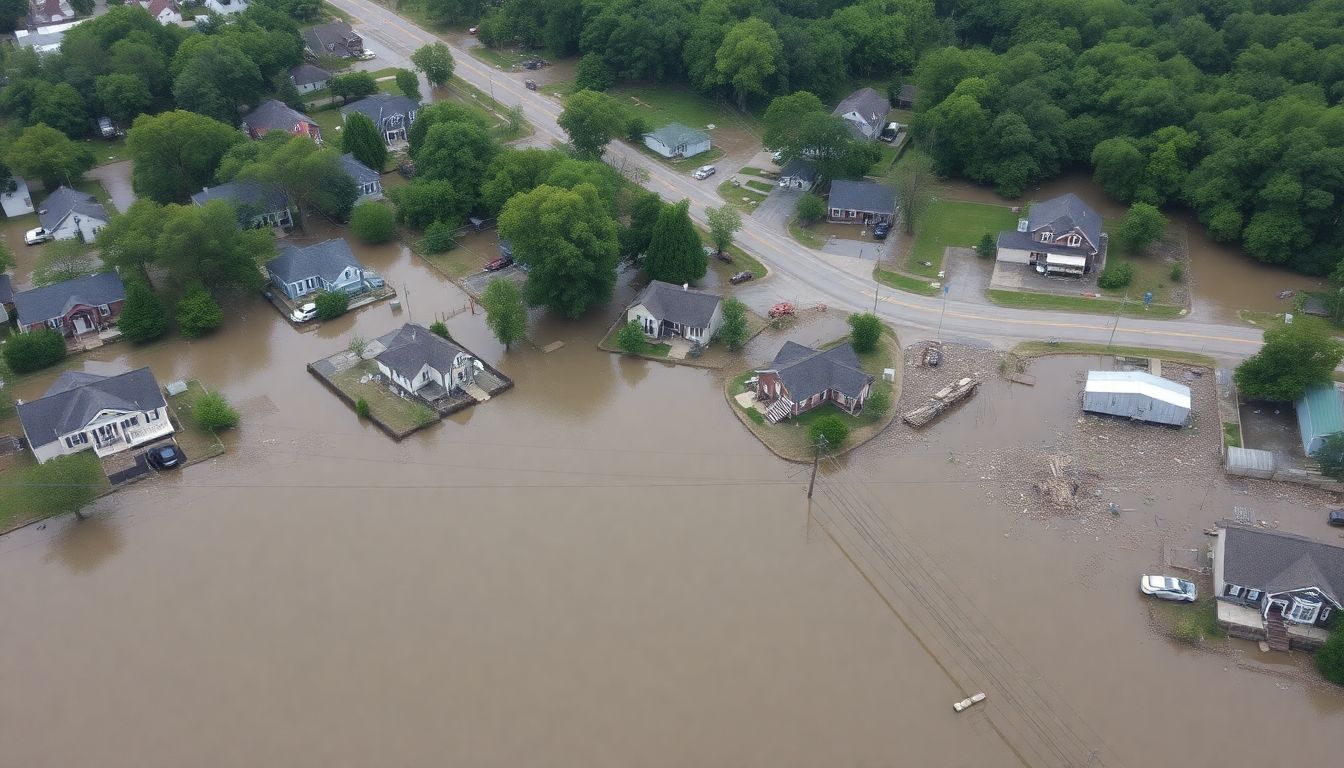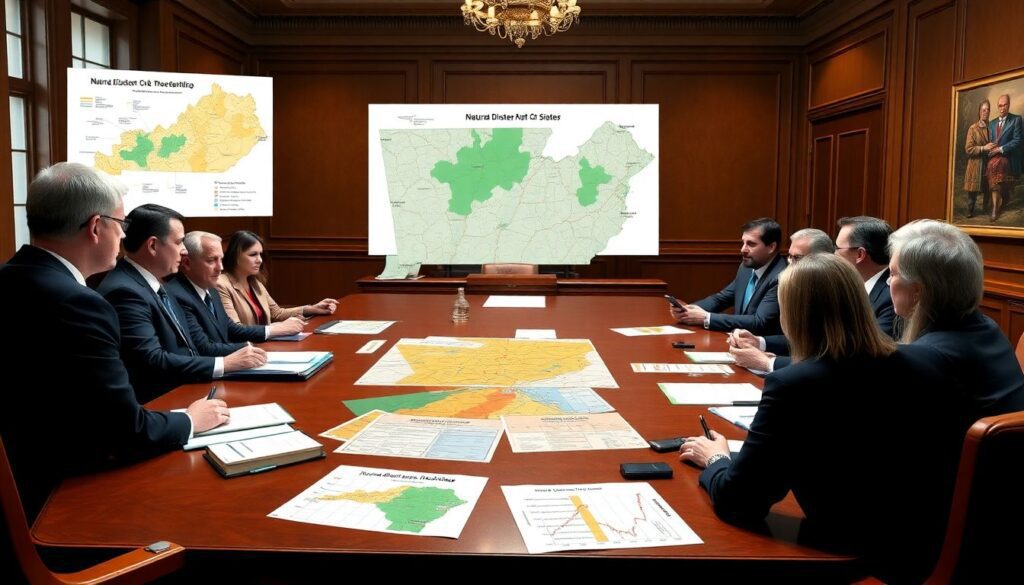Kentucky, a state known for its lush landscapes and rich cultural heritage, has recently faced the brunt of natural disasters, ranging from devastating tornadoes in the west to catastrophic flooding in the east. These events have left thousands of residents displaced and caused millions of dollars in damage. In response, Kentucky lawmakers are taking proactive steps to mitigate the impact of these natural disasters through legislation and strategic planning.
Proactive Measures to Protect Communities from Flooding and Tornadoes
In the stately chambers of the Kentucky State Capitol, lawmakers convene around a sprawling oak table, their faces etched with determination. The room hums with a symphony of rustling papers and hushed discussions, as they tackle one of the most pressing issues facing the Bluegrass State: natural disaster mitigation.
Spread out before them are large, intricately detailed maps, highlighting potential disaster zones in vivid hues. Reds and oranges blaze along the Mississippi and Ohio Rivers, marking areas at high risk of flooding. Swaths of yellow and green illustrate regions susceptible to tornadoes and severe storms, while blues indicate counties prone to landslides. The visual aid serves as a stark reminder of the challenges Kentucky faces, and the urgent need for robust mitigation plans.
Charts and graphs line the walls, outlining proposed strategies for minimizing risk and protecting citizens. One lawmaker, a veteran of the legislature, points to a bar graph illustrating the potential impact of early warning systems. Another, a freshman representative with a background in environmental science, discusses the benefits of investing in green infrastructure. As they debate and deliberate, the air thickens with a sense of purpose, each voice adding to the collective goal of fortifying Kentucky against the wrath of nature.

The Aftermath of Recent Natural Disasters
In the heart of the United States, the state of Kentucky has recently faced an onslaught of natural disasters, leaving a trail of devastation and heartache. The most notable events include the catastrophic tornadoes that tore through the region in December 2021. These twisters, which are now etched in history as some of the most destructive on record, leveled entire towns and communities. Among the hardest hit was Mayfield, where the tornado left a path of destruction so wide and so long that it changed the very landscape itself. Homes were reduced to splinters, businesses demolished, and precious lives lost. The sheer power of these tornadoes was a stark reminder of nature’s unpredictable and often brutal force.
As if the tornadoes weren’t enough, flooding has also taken a significant toll on Kentucky, particularly in the eastern part of the state. In July 2022, torrential rains led to widespread flooding that swept through communities, washing away homes, vehicles, and even entire families. The floodwaters didn’t discriminate, affecting both rural and urban areas, and leaving thousands of residents displaced and in distress. Roads and bridges were washed out, making rescue efforts challenging and isolating some communities entirely.
The impact of these disasters has been nothing short of devastating. Here are some of the key challenges faced by the affected communities:
-
Loss of Life:
The most tragic consequence has been the loss of life. Dozens of people perished in the tornadoes, and the flooding claimed even more lives, leaving families shattered and communities in mourning.
-
Property Damage:
The financial toll is staggering. From homes and businesses to infrastructure like schools, hospitals, and government buildings, the damage is extensive and will take years, perhaps even decades, to fully rebuild.
-
Economic Impact:
The disasters have dealt a severe blow to the local economy. Businesses have been disrupted or destroyed, leading to job losses and reduced economic activity.
Despite the overwhelming challenges, Kentuckians have shown remarkable resilience. Neighbors have come together to support one another, and communities have rallied to begin the long process of rebuilding. Yet, the road to recovery is fraught with obstacles. Lack of resources, insurance battles, and the emotional trauma of loss are all realities that residents must navigate. As Kentucky works to heal and rebuild, it serves as a sobering reminder of the power of nature and the importance of preparedness and community support in the face of such adversity.

Legislation and Task Force Creation
In the heart of the Bluegrass State, Kentucky, lawmakers have taken a proactive stance against the devastating impacts of natural disasters. The proposed legislation, a beacon of hope for communities frequently besieged by floods, tornadoes, and severe storms, aims to fortify the state’s resilience and ensure the safety of its residents. At the core of this initiative is the creation of a dedicated task force, a collective of experts and stakeholders united by a common goal: to study, mitigate, and minimize the impacts of natural disasters.
The task force, a carefully curated assembly, will comprise representatives from various state agencies, local governments, and non-profit organizations, as well as experts in the fields of meteorology, hydrology, and emergency management. Their mission? To pool their collective knowledge and resources to gain a comprehensive understanding of the unique challenges Kentucky faces. By examining historical data, assessing current infrastructure, and identifying potential vulnerabilities, the task force will paint a clear picture of the state’s risk landscape.
Once the task force has a firm grasp on the issues at hand, their focus will shift to actionable solutions. Their mandate includes:
- Developing early warning systems to enhance preparedness and response times.
- Fortifying critical infrastructure to withstand extreme weather events.
- Creating public education campaigns to empower residents with lifesaving knowledge.
- Fostering partnerships with federal agencies and neighboring states to ensure a coordinated approach to disaster management.
But the task force’s work doesn’t stop at mitigation. Recognizing that recovery is a critical component of disaster management, the legislation also tasks the group with developing strategies to expedite recovery efforts and ensure that affected communities bounce back stronger and more resilient than ever. This holistic approach, championed by Kentucky lawmakers, serves as a national model for disaster preparedness, mitigation, and recovery. It’s not just about weathering the storm, but about building a brighter, more resilient future for all Kentuckians.

Key Areas of Focus
The task force has a multifaceted mission that revolves around several key areas, each vital for enhancing community resilience and safety. At the heart of this initiative lies communication. Effective dissemination of information ensures that residents, businesses, and other stakeholders remain informed and prepared. The task force is committed to fostering a robust communication network that includes:
- Regular updates and alerts
- Community engagement events
- Educational campaigns
These efforts aim to bridge any information gaps and foster a culture of readiness.
Notification systems play a pivotal role in the task force’s strategy. Timely and accurate notifications can make a significant difference in emergency situations. By leveraging advanced technology and multi-channel approaches, the task force plans to implement systems that can swiftly alert residents in case of imminent threats. This includes:
- Emergency text alerts
- Mobile app notifications
- Social media updates
- Traditional media broadcasts
Ensuring that every member of the community receives critical information in real-time is a top priority.
The task force is also delving into the realm of building codes and insurance. Stricter, more resilient building codes can mitigate the impact of disasters by ensuring that structures are better equipped to withstand various threats. The task force is working on:
- Reviewing and updating existing building codes
- Promoting the adoption of hazard-resistant design standards
- Encouraging the use of resilient building materials
Additionally, the task force is collaborating with insurance providers to develop policies that incentivize risk reduction measures, making insurance more accessible and affordable for residents.
Lastly, the task force is emphasizing the importance of land use planning. Strategic land use planning can significantly reduce the risk of disasters and their subsequent impacts. By carefully assessing potential hazards and implementing smart growth strategies, the task force aims to:
- Limit development in high-risk areas
- Promote green infrastructure
- Encourage the creation of open spaces that can serve as buffers
Through these concerted efforts, the task force strives to create safer, more resilient communities that can effectively withstand and recover from disasters.

Expert Opinions and Future Outlook
In the realm of natural disaster management, experts universally agree that preparedness is the key to mitigating risk and saving lives. According to Dr. Lucy Jones, a renowned seismologist, ‘Disasters are not natural; they are the result of societies being poorly prepared.’ Being prepared involves more than just stockpiling supplies; it requires robust planning, community education, and infrastructure assessment. For instance, cities prone to earthquakes should invest in structural integrity and structures that can withstand seismic activity.
Technological advancements are revolutionizing our ability to forecast natural disasters more accurately and with greater lead time. Dr. Jennifer Francis, a senior scientist at the Woods Hole Research Center, notes that ‘improved satellite imagery, advanced modeling techniques, and AI-driven data analysis are enhancing our predictive capabilities.’ These tools enable scientists to monitor real-time data, identify patterns, and issue timely warnings. For example, the use of Doppler radar has significantly improved the accuracy of tornado forecasts, giving communities precious minutes to seek shelter.
Moreover, the integration of IoT (Internet of Things) devices and sensor networks is providing real-time data that can be crucial in disaster management. Dr. Costas Synolakis, a tsunami expert, explains that ‘early warning systems equipped with sensors can detect the slightest changes in sea levels, triggering alerts that can save thousands of lives.’ These technological advancements are not just about forecasting but also about effective communication and rapid response.
Looking ahead, experts envision a future where technology and preparedness converge to create resilient communities. Here are some potential improvements:
-
Enhanced Early Warning Systems:
Leveraging 5G networks for faster data transmission and more accurate real-time monitoring.
-
AI and Machine Learning:
Utilizing these technologies to predict disaster patterns and simulate various scenarios for better preparedness.
-
Community Engagement Platforms:
Developing user-friendly apps and platforms that provide instant alerts, safety tips, and evacuation routes.
In the words of Dr. Irwin Redlener, director of the National Center for Disaster Preparedness, ‘the more we invest in preparedness and technology, the better equipped we will be to face the challenges of natural disasters.’
FAQ
What are the main natural disasters affecting Kentucky?
What is the proposed legislation aimed at?
What are the key areas of focus for the task force?
- Communication and notification
- Building codes and insurance
- Land use planning









